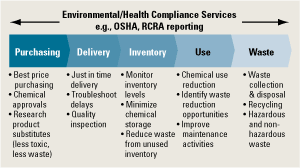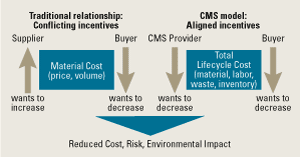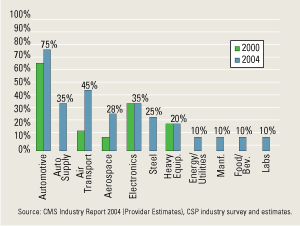Chemical management services offer a new business model that can
reduce cost and keep companies compliant with regulatory challenges.
The printed circuit board industry is just catching its collective breath after complying with the European Union (EU) directive RoHS – the Restriction of Certain Hazardous Substances in electrical and electronic equipment. But the industry and its chemical supply chain must be prepared for more. A new EU regulation goes into effect June 1, 2007 called REACH – the Registration, Evaluation and Authorization of Chemicals. REACH requires toxicity and safety information for an estimated 30,000 chemicals. It also has strict requirements for communicating information on chemical properties and safe uses up and down the supply chain.
The cost to properly manage chemicals and the increasing risk to production and sales requires more attention to the chemical supply chain. Chemicals are a critical component in PCB manufacturing, but they are perceived as a relatively small percentage of operational costs and often purchased through distributors.
Companies like General Motors (GM) and Seagate Technology have implemented a new supply chain model termed “chemical management services” with stunning results. They are part of a growing trend of manufacturing industries working to transform their chemical supply chain and extracting higher value from these new performance-based relationships.
What are Chemical Management Services?
Nearly 20 years ago, GM realized that they had thousands of individual suppliers providing them tens of thousands of different chemicals. They had legal obligations to track chemicals coming through their plants, the financial impact of bloated inventories and risk issues related to the stock of chemicals present on their sites. As they considered how to gain better control of their chemical throughput, they turned to their chemical suppliers to provide a solution. GM asked several suppliers to serve as integrators. They began to purchase and manage GM’s chemicals for a fixed price. They even agreed to annual cost reduction goals. This simple shift in the supply chain relationship led to the birth of chemical management services (CMS).
Today, GM has implemented CMS in nearly 90% of its plants worldwide. When a program is implemented, GM generally realizes a 30% reduction in chemical use and a 30% reduction in the cost of purchased chemicals and associated management activities1.
But can a program that works at a GM plant work for the electronics industry? The answer is yes. Seagate began its program over three years ago with similar results. Over the past 10 years, CMS has been adopted by the automotive supply, aerospace, air transport, utility, steel, research, semiconductor, electronics and biotech industries. There was even a working example at a GM PCB facility, Delco Electronics in Kokomo, IN, that ran successfully from in the mid-1990s with Enthone as the Tier 1 manager. In the late 1990s GM decided to exit the PCB manufacturing business, closing the PCB facility in IN. The CMS model has broad application, and it is particularly successful because each program is tailored to the operating environment where it is implemented.
The CMS Model
Chemical management begins with procurement, and spans the activities associated with the use and disposal of the chemical. A CMS provider may purchase and deliver chemicals, maintain the inventory and track MSDSs. They also may provide a broader range of services including process efficiency improvement, data collection for environmental monitoring and reporting, analytical laboratory management services, and waste collection and disposal (Figure 1).
|

FIGURE 1. Scope of services available in a CMS program.
|
At each stage, a company incurs costs of labor, materials, equipment and the more elusive costs of space, capital and liability, all to support the management of the chemicals. In research conducted by the non-profit organization Chemical Strategies Partnership (CSP), the cost of chemical management can range from $1 to $3 for every dollar of chemical purchased2. That means for a facility purchasing $3 million in chemicals, they may spend an additional $3 to $9 million managing those chemicals. These high costs are due to the concealed expenses behind chemical use like compliance, safety, disposal and floor space.
For most manufacturing companies, chemical management is not considered part of the core business. Chemicals are a very important part of manufacturing, but managing them is not generally a process that attracts much management attention – until something goes wrong. As a result, chemical management often does not run as efficiently and cost effectively as other manufacturing processes.
Staying Ahead of the Regulatory Curve
One of the most significant benefits from a CMS program is getting a full picture of what chemicals your company buys, how much is spent on chemicals and where they are located on your site. This is extremely important information for the local fire marshal as well as the state and EU as new regulations begin to kick in. The EU’s REACH regulation taking effect June 1, 2007 goes farther than RoHS. REACH will require importers and manufacturers of an estimated 30,000 chemicals to perform toxicity and other testing to demonstrate safety in consumer use. It also includes strict requirements for communicating information on chemical properties and safe uses up and down the supply chain. This two-way supply chain communication marks one of several differences with REACH vs. RoHS3. In addition, there are numerous states starting to enact restrictions and bans of specific substances. Proactively managing your chemicals will allow your company to identify potential substances that may be restricted and offer more time to prepare.
Cost Reductions and Improved Performance Incentives
Typically, when a CMS program is implemented cost savings ranging from 5% to 20% are realized in the first year. In years two and three, savings continue and average approximately 6% to 10% a year4. How does this happen? One of the most unique aspects of CMS is the fundamental transformation of the chemical supply chain. In traditional supplier-customer relationships, the chemical supplier’s profitability is a function of the volume sold. The more chemicals sold, the higher the revenue for the supplier. Meanwhile, the buyer has an opposite incentive – to reduce costs or the amount of chemicals purchased. In the CMS model, suppliers become chemical management providers and are paid for successfully delivering and managing chemicals. Thus, the supplier’s profitability is based on better performance, not on selling more chemicals (Figure 2).
|

FIGURE 2. Aligning incentives.
|
The supplier’s profitability is now independent of the volume of chemicals sold. In other words, the suppliers no longer get paid based on how well they can sell, but how well they can manage. This is accomplished by establishing supplier compensation on performance-based metrics and fees. In the case of GM, the chemical service provider is compensated per car successfully rolled off the assembly line (or per 1,000 circuit boards produced). Thus, chemicals become an operational cost to the supplier instead of the manufacturer. As with labor, utilities and other material inputs, the supplier now has an incentive to use fewer chemicals to yield higher margins. The manufacturer gains a partner in its efforts to manage chemicals more efficiently; the supplier becomes an integral part of the business by providing a differentiated, value-added service.
Implementing CMS in a PCB Company
Every company has a chemical management system by design or default. If chemical management is not a stated priority for the company, it is likely there are significant improvements that can be made. Thus, it is a challenge to secure resources to make improvements in a system that often is not considered a core competency of the business. CMS providers perform more effectively and at a lower cost than companies can do by themselves if they embark on improving their own system.
Each CMS program is unique to each company. Some companies consider a narrow scope of chemical management services to get started. For example, a CMS provider might purchase and deliver chemicals, manage MSDSs, pick up waste and provide data for some environmental reports. Later, they might expand the scope of services to include research and testing for chemical substitutes and process efficiency improvements.
The added benefit of this new type of relationship is a built-in incentive for the CMS provider to deliver continuous improvements. As outlined above, the chemical service model delivers results by aligning the incentives of chemical suppliers and their customers. Most CMS contracts then have additional incentives to inspire the CMS provider to bring new ideas and improvements to the plant floor.
Getting your chemical management system in order has benefits on many levels. Aside from lowering costs, some primary reasons companies launch a strong effort to improve their chemical management include:
- Leveraging the expertise of a supplier.
- Freeing up floor space for manufacturing.
- Improved information management without investing in expensive software.
- Reducing chemical use to drop emissions below environmental reporting thresholds.
- Improving staff productivity by eliminating chemical management tasks from their overall responsibilities.
- Increasing employee safety.
Case Study: Seagate Technology
Seagate Technology began its CMS program in 2003 seeking to reduce costs, reduce chemical inventory on-hand to free up more space for production and reduce overall risk to the company5. They realized that chemical management was not their core competency and turned to a third party provider to help them. When Seagate conducted a baseline at one site to understand current costs and management processes, they discovered that they had approximately 150 direct chemical suppliers, 900 chemical purchase orders a year and 23 employees dealing with chemical management. After implementing their program, they had one CMS provider submitting one invoice monthly, they moved toward a web-based system for MSDSs and chemical ordering, and were guaranteed cost savings from their CMS provider. In addition, they realized other benefits:
- Reduced onsite chemical inventory/handling.
- Reduced 10,000 sq. ft. of inventory by 50%.
- Reduced $800,000 in carrying costs of chemicals.
- Eliminated chemical scrap (chemicals bought and never used) by approximately 7% of inventory.
- Improved chemical processes/shared best practices.
- Photo-resist process: substituted more benign product and extended bath life 3-5 times, resulting in savings of $50,000/month.
Seagate is rolling out their CMS program worldwide where they have 18 sites that use chemicals. Eleven of those sites spend less than $1 million in chemical. Their CMS program must be global, flexible and fast to accommodate the diversity of chemicals and processes at these sites. CMS programs are becoming more commonplace in North America, where an estimated 35% of electronics industry manufacturing is now using some form of CMS program (Figure 3).
|

FIGURE 3. CMS as a growing trend – estimated CMS market penetration (North America).
|
The time is ripe to focus attention on your chemical supply chain. Considering a new approach to managing your chemical supply chain is essential as the regulatory and competitive environment becomes ever more intense. Companies in the PCB and electronics industries have had good success in reducing costs, improving efficiency and reducing risk through implementing CMS programs. PCD&M
Ed.: Information and resources on the CMS model: chemicalstrategies.org and cmsforum.org.
Jill Kauffman Johnson is the executive director of Chemical Strategies Partnership (CSP), a non-profit research, education and consulting organization. She can be contacted at This email address is being protected from spambots. You need JavaScript enabled to view it..
REFERENCES
1. Chemical Management Services Industry Report 2004, pg. 19.
2. 2004 CMS Workshop, October 14, 2004, Dallas, Texas.
3. “Will REACH really be like RoHS on steroids?”, Keith Huckle, Global Product Steward, Dow Corning, EE Times, Online. eetimes.eu/wireless/showArticle.jhtml?articleID=191801423
4. Chemical Management Services Industry Report 2004, pg. 19.
5. Seagate Technology presented information about their CMS program at the 2005 CMS Workshop in San Francisco. Presentation can be viewed at chemicalstrategies.org/pdf/workshop_events/KStorer_CaseStudy_1.pdf
















